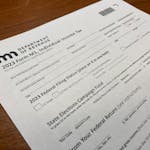 See
more of the story
See
more of the story
Last year was a record year for the solar power industry and, after working through a little slump, the forecast is for growth as far as the eye can see. Yet there was also news last week that a high-profile company, Ten K Solar of Bloomington, will be scaling down.
One obvious conclusion — management must have run this company into the ground — doesn't seem at all fair. A far better explanation is that as the relatively young industry of solar energy equipment turned into a big one, it's already produced market-share leaders that enjoyed the benefits of being the biggest, including lower costs. Ten K Solar wasn't one of those big companies.
Ten K Solar did not exactly say it was shutting down. Instead it said last week, in part, "after a thorough pursuit of all strategic options, the company has decided to reposition the business to live within the constraints of these marketplace realities." The company, through a spokesman, declined further explanation, other than noting that technical issues with its equipment were not factors in the decision.
And while this statement's language was a bit of a head scratcher, in conversations with people in the solar industry this week no one sounded surprised Ten K Solar will be winding down.
That's because the market realities affecting Ten K Solar are the same as cited by solar companies Suniva and Sungevity as they went into bankruptcy this year along with the German version of bankruptcy for SolarWorld AG, a company with a large manufacturing facility in Oregon. Other solar equipment companies have cut back staff or operations.
"The situation can be summarized as one of economic competitiveness, in this case the price competitiveness of photovoltaic module suppliers in Asia versus the relatively high price of domestic suppliers in the United States," explained market analyst Camron Barati at IHS Markit, in an e-mail.
"Since the second half of 2016, PV [photovoltaic] module prices globally have plummeted much faster than many suppliers could keep pace with, reaching approximately $0.35 per watt today, which is approximately 36 percent cheaper than the average price experienced just two years ago."
The glut developed as the industry now has, according to Bloomberg, 90 percent of the sales going to just a handful of producers. All of them were reluctant to cut production rates — and give away hard-earned market share.
Ten K Solar started in '08 and reportedly got basic PV panels most recently from a manufacturer in Asia. Buying from Asia would seem to be a way for Ten K Solar to take advantage of the lower prices, too. As explained by industry insiders familiar with Ten K Solar, though, it was still at a cost disadvantage compared to bigger companies. It didn't get the same price, payment terms and shipping guarantees.
And falling prices for the basic panel were a mixed blessing for domestic producers like Ten K Solar, and that's related to the cost of PV panels as a percentage of the total cost. Ten K Solar was a premium supplier, serving the niche in the market of commercial scale rooftop solar. Ten K Solar went out to the market with a differentiated product line, including the way it wired its systems.
A conventional panel generally has the photovoltaic cells wired in serial, one after the other sort of like the way a strand of Christmas tree lights connects the bulbs. Ten K Solar wired in parallel as well, creating what it called a matrix.
That matrix idea sought to eliminate the risk of a single cell's failure creating a roadblock in the current flowing through the system, as well as improve the energy generating performance when cells got shaded or soiled. On the other hand, Ten K Solar's matrix also added costs. And as PV panels declined in price, the costs to complete a system became a bigger part of the overall cost.
As described by the veteran Twin Cities installer Ralph Jacobson of Innovative Power Systems, a contributing factor could have been lower-than-planned demand due to a federal tax law change the industry actually had sought. Passed at the end of 2015, it extended the availability of investment tax credits for solar installations that the industry had expected to end last year.
While the tax credit extension was still up in the air, the solar industry had hustled to get a lot of projects teed up to be put into service last year to make them eligible for the federal tax credits. That urgency to install solar evaporated as the availability of tax credits was extended into future years.
Innovative Power had installed a number of Ten K Solar systems, so "let's say I'm not happy" about the shutdown of the company, Jacobson said. Ten K Solar customers had been counting on an improvement to one key part of the electronics, and having the company wind things up will make upgrading those systems more challenging.
He hasn't lost his optimism for the industry, though, and one big reason is that the lower prices are accelerating the transition to the kind of mature market the solar energy pioneers always envisioned.
Roseville-based Innovative Power Systems has been around since 1991, and its first solar generation projects were installed by wealthy people determined to have solar power, no matter what the cost. Then investors with an appetite for federal tax credits to offset their tax liability became the driving force in the market's growth.
While still in place, the credits are going to be stepping down, under current law. But now solar generation is finally getting cheap enough to make sense to ordinary homeowners and small businesses.
And Ten K Solar's products will be missed in the market, Jacobson said. "The module itself was fabulous," he said. "We never had any problems with one of those."
lee.schafer@startribune.com 612-673-4302




